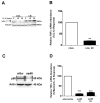Transcription of the gene encoding TNF-α is increased by IL-1β in rat and human islets and β-cell lines
- PMID: 24972324
- PMCID: PMC4157113
- DOI: 10.1016/j.molimm.2014.05.019
Transcription of the gene encoding TNF-α is increased by IL-1β in rat and human islets and β-cell lines
Abstract
Synthesis and secretion of immunomodulatory proteins, such as cytokines and chemokines, controls the inflammatory response within pancreatic islets. When this inflammation does not resolve, destruction of pancreatic islet β-cells leads to diabetes mellitus. Production of the soluble mediators of inflammation, such as TNF-α and IL-1β, from resident and invading immune cells, as well as directly from islet β-cells, is also associated with suboptimal islet transplantation outcomes. In this study, we found that IL-1β induces rapid increases in TNF-α mRNA in rat and human islets and the 832/13 clonal β-cell line. The surge in transcription of the TNF-α gene required the inhibitor of kappa B kinase beta (IκKβ), the p65 subunit of the NF-κB and a signal-specific recruitment of RNA polymerase II to the gene promoter. Of note was the increased intracellular production of TNF-α protein in a manner consistent with mRNA accumulation in response to IL-1β, but no detectable secretion of TNF-α into the media. Additionally, TNF-α specifically induces expression of CD11b, but not CD11c, on neutrophils, which could contribute to the inflammatory milieu and diabetes progression. We conclude that activation of the NF-κB pathway in pancreatic β-cells leads to rapid intracellular production of the pro-inflammatory TNF-α protein through a combination of specific histone covalent modifications and NF-κB signaling pathways.
Keywords: Cytokine; Diabetes mellitus; Inflammation; Islet; NF-κB; Transcription.
Copyright © 2014 Elsevier Ltd. All rights reserved.
Figures





Similar articles
-
Induction of nuclear factor-kappaB and its downstream genes by TNF-alpha and IL-1beta has a pro-apoptotic role in pancreatic beta cells.Diabetologia. 2008 Jul;51(7):1213-25. doi: 10.1007/s00125-008-0999-7. Epub 2008 May 8. Diabetologia. 2008. PMID: 18463842
-
Cytokine-mediated induction of anti-apoptotic genes that are linked to nuclear factor kappa-B (NF-kappaB) signalling in human islets and in a mouse beta cell line.Diabetologia. 2009 Jun;52(6):1092-101. doi: 10.1007/s00125-009-1331-x. Epub 2009 Apr 3. Diabetologia. 2009. PMID: 19343319
-
Differential usage of NF-κB activating signals by IL-1β and TNF-α in pancreatic beta cells.FEBS Lett. 2012 Apr 5;586(7):984-9. doi: 10.1016/j.febslet.2012.02.021. Epub 2012 Feb 22. FEBS Lett. 2012. PMID: 22569251
-
Calcineurin/nuclear factor of activated T cells and MAPK signaling induce TNF-{alpha} gene expression in pancreatic islet endocrine cells.J Biol Chem. 2011 Jan 14;286(2):1025-36. doi: 10.1074/jbc.M110.158675. Epub 2010 Nov 8. J Biol Chem. 2011. PMID: 21059644 Free PMC article.
-
IL-17 in type II diabetes mellitus (T2DM) immunopathogenesis and complications; molecular approaches.Mol Immunol. 2024 Jul;171:66-76. doi: 10.1016/j.molimm.2024.03.009. Epub 2024 May 24. Mol Immunol. 2024. PMID: 38795686 Review.
Cited by
-
Inflammation: A Target for Treatment in Spinal Cord Injury.Cells. 2022 Aug 29;11(17):2692. doi: 10.3390/cells11172692. Cells. 2022. PMID: 36078099 Free PMC article. Review.
-
An Agonist of the Protective Factor SIRT1 Improves Functional Recovery and Promotes Neuronal Survival by Attenuating Inflammation after Spinal Cord Injury.J Neurosci. 2017 Mar 15;37(11):2916-2930. doi: 10.1523/JNEUROSCI.3046-16.2017. Epub 2017 Feb 13. J Neurosci. 2017. PMID: 28193684 Free PMC article.
-
Compound A attenuates proinflammatory cytokine-induced endoplasmic reticulum stress in beta cells and displays beneficial therapeutic effects in a mouse model of autoimmune diabetes.Cell Mol Life Sci. 2022 Nov 12;79(12):587. doi: 10.1007/s00018-022-04615-5. Cell Mol Life Sci. 2022. PMID: 36370223 Free PMC article.
-
Human serum enhances the proliferative capacity and immunomodulatory property of MSCs derived from human placenta and umbilical cord.Stem Cell Res Ther. 2019 Mar 7;10(1):79. doi: 10.1186/s13287-019-1175-3. Stem Cell Res Ther. 2019. PMID: 30845980 Free PMC article.
-
Engineering biomimetic materials for islet transplantation.Curr Diabetes Rev. 2015;11(3):163-9. doi: 10.2174/1573399811666150317130440. Curr Diabetes Rev. 2015. PMID: 25776871 Free PMC article. Review.
References
-
- Hotamisligil GS, Shargill NS, Spiegelman BM. Adipose expression of tumor necrosis factor-alpha: direct role in obesity-linked insulin resistance. Science. 1993;259:87–91. - PubMed
-
- Meldrum DR. Tumor necrosis factor in the heart. Am J Physiol. 1998;274:R577–595. - PubMed
-
- Oral H, Kapadia S, Nakano M, Torre-Amione G, Lee J, Lee-Jackson D, Young JB, Mann DL. Tumor necrosis factor-alpha and the failing human heart. Clinical cardiology. 1995;18:IV20–27. - PubMed
Publication types
MeSH terms
Substances
Grants and funding
LinkOut - more resources
Full Text Sources
Other Literature Sources
Research Materials

